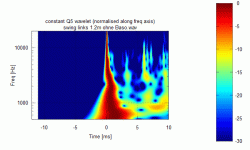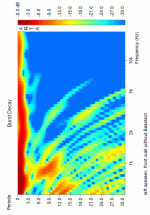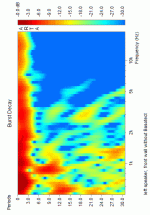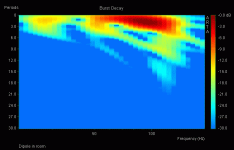Thanks John.
Well, from this alone it's obvious that monopole is the better sub. Dipole/cardioid offers no real improvement and with less output. And they cost more as well.
I personally don't understand the word "pressurization". It's a term I have never heard used in acoustic circles. Can you explain further what you mean by it?
Well, from this alone it's obvious that monopole is the better sub. Dipole/cardioid offers no real improvement and with less output. And they cost more as well.
I personally don't understand the word "pressurization". It's a term I have never heard used in acoustic circles. Can you explain further what you mean by it?
Well.. in near-anechoic situations there should be no difference between a dipole and monopole. Or between a controlled and bad directivity for that matter ....
Pressurization: what I understand with this is that the speaker can generate a "static" sound pressure in the room, globally speaking.
A monopole can do this. A dipole can not since both + and - periods of the signal is released into the room.
No pressurization is perhaps the main reason dipoles are more neighbor-friendly than monopoles.
Pressurization: what I understand with this is that the speaker can generate a "static" sound pressure in the room, globally speaking.
A monopole can do this. A dipole can not since both + and - periods of the signal is released into the room.
No pressurization is perhaps the main reason dipoles are more neighbor-friendly than monopoles.
I'll post the impulse responses.
Great !
I can run similar modulation analysis as I did here:
Elias Pekonen Home Page - Dipole Bass vs Monopole Bass
I don't listen to test signals. I have no idea what they are supposed to sound like.
As far as music goes, you may recall that the original NaO II had a woofer system which could be mechanically and electrically converted between U-frame quasi-cardioid and sealed box, with identical free field response. The NaO II RS has only the U-frame cardioid. That should tell you something.
It may true that in your purpose built dedicated listening room cardioid performs well enough.
But how about those of us who live in a concrete boxes ?
Also, in this test I am not trying to find optimum position for the placement of the woofers. I'm interested in how they perform in a typical stereo speaker setup.
The bass reproduction in a typical stereo speaker setup has been may goal also ! Maybe I should have expressed that more clearly in the beginning of the thread, too.
- Elias
Yes and there are steel bars in front of the windows
The walls at my current place are about 70cm (2.3ft) thick.
Well, I dont have steel bars in the window, but my walls are 'only' 50cm thick brick and cement.
These walls don't have any of 'damping' properties... It's a whole new problem scenario.
Well, I dont have steel bars in the window, but my walls are 'only' 50cm thick brick and cement.
Steel bars aren't needed for you guys up there, the weather wouldn't allow one to step outside anyways.
wow.. 70cm walls! torture room? 
my concrete box is "only" made of 25cm thick walls and I do have issues with two fairly large resonances below 80hz. I use dipoles. the funny thing is measurements did not show much difference with the speaker placed right on the corner, I thought it would cancel all modes..
more subjectively, aren't dipoles meant to give an edge on "natural" LF reproduction? less energy storage + less group delay compared to ported subs, and even closed boxes?

my concrete box is "only" made of 25cm thick walls and I do have issues with two fairly large resonances below 80hz. I use dipoles. the funny thing is measurements did not show much difference with the speaker placed right on the corner, I thought it would cancel all modes..
more subjectively, aren't dipoles meant to give an edge on "natural" LF reproduction? less energy storage + less group delay compared to ported subs, and even closed boxes?
Last edited:
John,
your Arta burst decays may be good for detecting driver resonance issues, but they are inferior to Elias' methods when you want to see room dependent timing issues. You may compare my diagrams, which show the influence of some front wall absorption http://www.diyaudio.com/forums/mult...resentation-loudspeaker-room-interaction.html:

In the above diagram you can clearly recognize the attenuated front wall reflection at 7 ms. This is much less visible in the Arta burst decay diagrams from the same IR measurements:


your Arta burst decays may be good for detecting driver resonance issues, but they are inferior to Elias' methods when you want to see room dependent timing issues. You may compare my diagrams, which show the influence of some front wall absorption http://www.diyaudio.com/forums/mult...resentation-loudspeaker-room-interaction.html:

In the above diagram you can clearly recognize the attenuated front wall reflection at 7 ms. This is much less visible in the Arta burst decay diagrams from the same IR measurements:


50cm thick walls! The only homes like that in the UK are either at least 200years old or of the 'stately' type. Or both.
However, i once lived in a pre-fab concrete building, and whenever a bassist hit the B string open on a 5 string bass the room shook! Considering the speakers were only 5 inch audax, and f3 of the box was circa 55hz, this mode gave a useful boost. If a little hungover. The upper bass modes were far less noticable. The effect of concrete floor and walls was most objectionable in the midrange.
In that room i would never have used a dipole, whatever improvement could be realised in bass mode reduction was, to me, stolen away by the 'swimming pool' sound of the mids. Difficult rooms dont necessarily require a dipole solution alone, room treatment is almost certainly required. John K's listening room seems a logical approach to tame a concrete coffin
However, i once lived in a pre-fab concrete building, and whenever a bassist hit the B string open on a 5 string bass the room shook! Considering the speakers were only 5 inch audax, and f3 of the box was circa 55hz, this mode gave a useful boost. If a little hungover. The upper bass modes were far less noticable. The effect of concrete floor and walls was most objectionable in the midrange.
In that room i would never have used a dipole, whatever improvement could be realised in bass mode reduction was, to me, stolen away by the 'swimming pool' sound of the mids. Difficult rooms dont necessarily require a dipole solution alone, room treatment is almost certainly required. John K's listening room seems a logical approach to tame a concrete coffin
Last edited:
In that room i would never have used a dipole, whatever improvement could be realised in bass mode reduction was, to me, stolen away by the 'swimming pool' sound of the mids. Difficult rooms dont necessarily require a dipole solution alone, room treatment is almost certainly required. John K's listening room seems a logical approach to tame a concrete coffin
you are right, anything above 90db becomes horrible. I am experimenting with bbc absorbing modules but don't have enough of them yet. and my furnishing is on the light side.. you also need EQ too, for sure! so it's definitely a more complex picture if you want to reach a really good level.
Thanks John.
Well, from this alone it's obvious that monopole is the better sub. Dipole/cardioid offers no real improvement and with less output. And they cost more as well.?
Well, if on graphs, dipoles look so similar to monopoles...how to they sound so different to many including SL, ? JohnK, ?Martin King. Not to mention the many successful commercial models which are dipoles.
It seems that the graphs by John are missing to capture something very deciding. However, the graphs by Elias told a different story more in sync with subjective perceptions. Even Dr. Geddes agrees that dipoles sound "different". Then why should the graphs look the same ??!!
Because of superposition.Well, if on graphs, dipoles look so similar to monopoles...how to they sound so different to many including SL, ? JohnK, ?Martin King. Not to mention the many successful commercial models which are dipoles.
It seems that the graphs by John are missing to capture something very deciding. However, the graphs by Elias told a different story more in sync with subjective perceptions. Even Dr. Geddes agrees that dipoles sound "different". Then why should the graphs look the same ??!!
Triggers different standing waves.
Dipole/cardioid are not directional at all frequencies. They are only directional at certain frequencies depending upon the degree of spacing/separation. The polar response isn't uniform/static for all frequencies. A polar plot would show lobing. Hence, the term pressurazation is meaningless IMO.
I for one am completly with John on this. He did preceisly the right test in the right way in a room that was designed and built for listening. Anything else is a compromise of some sort. Sure we can talk about what "compromise" is best for you guys who do not have the option of building a dedicated room, but then please be clear that you are always talking about "a compromise" situation, not the best situation. This fact makes John and I - whose rooms appear to be very very similar, almost identical - completely at odds with everyone else as far as what we are using as a basic assumption for our discussions and measurements. Our rooms are well designed for LF reproduction and should be expected to work that way.
My pieve has been the presumption that "dipoles are best" and then when it is shown that this simply isn't true in a low compromise situation the excuse is that "Well what about the performance in a bad room?" That is not what the discussion should be about. It should be about how we can get the best bass for our reproduction systems, and the "minimum compromise" situation should be assumed, not the other way arround.
Soundaatma
Room Pressurization - in a sealed room there is a mode at 0,0,0 which is at DC, it can support a static change in the prssure through a static movment of the sub cone. But no real room can be sealed so this mode has to move away from f = 0. It can move to higher frequency if the "air leaks" (HVAC at a minimum) are mass-like then the room is like being inside of a helmholtz resonator. It can also move away from zero but purely imaginary when the air leak is far more resistive than mass-like. This mode can have substantial effects in small rooms, particularly cars, but as the room gets larger and leakier its effects will diminish and eventually vanish altogether.
My pieve has been the presumption that "dipoles are best" and then when it is shown that this simply isn't true in a low compromise situation the excuse is that "Well what about the performance in a bad room?" That is not what the discussion should be about. It should be about how we can get the best bass for our reproduction systems, and the "minimum compromise" situation should be assumed, not the other way arround.
Soundaatma
Lets be sure to clarify this. I was refering to their sound quality above 125 Hz, not below. So that comment does not apply to this discussion. Below 125 Hz I think that the subs should be monopoles, not dipoles (because thieir isn't much diofference when the subs are setup properly and the monopoles are just more efficient). I would use a dipole from 125 Hz - 500 Hz and then blend in the monopoles below 125 - 150 Hz.Even Dr. Geddes agrees that dipoles sound "different". Then why should the graphs look the same ??!!
Room Pressurization - in a sealed room there is a mode at 0,0,0 which is at DC, it can support a static change in the prssure through a static movment of the sub cone. But no real room can be sealed so this mode has to move away from f = 0. It can move to higher frequency if the "air leaks" (HVAC at a minimum) are mass-like then the room is like being inside of a helmholtz resonator. It can also move away from zero but purely imaginary when the air leak is far more resistive than mass-like. This mode can have substantial effects in small rooms, particularly cars, but as the room gets larger and leakier its effects will diminish and eventually vanish altogether.
Last edited:
That's wrong. Why do you think cardioid are used for SR? In anechoic rooms there is absolutely a difference in regards to their polar responses. Outdoor both cardiod and dipole work as being directional. In a small bounded space however, much of the advantage of the directional localized direct polar distribution is lost.Well.. in near-anechoic situations there should be no difference between a dipole and monopole. Or between a controlled and bad directivity for that matter ....
mondo, lolo ... I had some issues with higher SPL at some point as well. I revisited the crossover solution which made a positive impact on the midrange clarity. The woofer in my 2-way had a out of band spike that i hadn't dealt with at all. I believe things like this lead to SPL problems w'dipole as well.
I use a couple of older dsp units that have some PEQ functions per "way". I was able to implement a filter within the transition band of both the woofer/mid and tweeter. The filters simulated to be symmetrical as for Q and attenuation on both sides of the xo point.
The addition of the filter(s) resulted in a steeper transition slope ... one that was not attainable purely with the dsp's xo settings. All said, it seems to have improved the polars and directivity. As one can guess, this will result in better in room response, especially if the room has marginal treatment.
I use a couple of older dsp units that have some PEQ functions per "way". I was able to implement a filter within the transition band of both the woofer/mid and tweeter. The filters simulated to be symmetrical as for Q and attenuation on both sides of the xo point.
The addition of the filter(s) resulted in a steeper transition slope ... one that was not attainable purely with the dsp's xo settings. All said, it seems to have improved the polars and directivity. As one can guess, this will result in better in room response, especially if the room has marginal treatment.
Ok, here we go:
Near filed of the monopole source. All sources would have this anechoic far field axial response.
Frequency response:

Burst response in CSD form:

In room 3 meter measurements. Same mic and source positions as before:
Monopole:
Frequency response:

Burst sonogram:

Burst waterfall:

Dipole:
Frequency response:

Burst Sonogram:

Burst waterfall:

Cardioid:
Frequency Response:

Burst Sonogram:

Burst waterfall:

Overlay of frequency responses:

Note that since most of these figures have the same names as the original ones, they will appear in my original post. SO DON'T GET CONFUSED.
Frankly the only noticeable difference is in the frequency response. There are some differences in the burst sonograms as well because of choosing a different plotting option.
FWIW, from my perspective my conclusion remains what it was when I first designed the CRAW, cardioid woofers just seem to work a little better. [edit] With regards to frequency response and sensitivity to position.
[edit] Apparently the original figures are still displayed in the original post (#376 on page 38). I don't know how that works being that I deleted the originals from my site. I guess nothing on the internet ever really goes away.
Near filed of the monopole source. All sources would have this anechoic far field axial response.
Frequency response:

Burst response in CSD form:

In room 3 meter measurements. Same mic and source positions as before:
Monopole:
Frequency response:

Burst sonogram:

Burst waterfall:

Dipole:
Frequency response:

Burst Sonogram:

Burst waterfall:

Cardioid:
Frequency Response:

Burst Sonogram:

Burst waterfall:

Overlay of frequency responses:

Note that since most of these figures have the same names as the original ones, they will appear in my original post. SO DON'T GET CONFUSED.
Frankly the only noticeable difference is in the frequency response. There are some differences in the burst sonograms as well because of choosing a different plotting option.
FWIW, from my perspective my conclusion remains what it was when I first designed the CRAW, cardioid woofers just seem to work a little better. [edit] With regards to frequency response and sensitivity to position.
[edit] Apparently the original figures are still displayed in the original post (#376 on page 38). I don't know how that works being that I deleted the originals from my site. I guess nothing on the internet ever really goes away.
Last edited:
My pieve has been the presumption that "dipoles are best" and then when it is shown that this simply isn't true in a low compromise situation the excuse is that "Well what about the performance in a bad room?" That is not what the discussion should be about. It should be about how we can get the best bass for our reproduction systems, and the "minimum compromise" situation should be assumed, not the other way arround.
 I do not agree with this. Not everybody has the privilege to own his house and have a dedicated room. What about people living in tiny appartments? that's the majority in EU for example. No possibility to do heavy treatments of any sort. Does your solution work for them too?
I do not agree with this. Not everybody has the privilege to own his house and have a dedicated room. What about people living in tiny appartments? that's the majority in EU for example. No possibility to do heavy treatments of any sort. Does your solution work for them too? And I am sorry but if we are discussing differences in speakers only (the title of this thread!) we have to take the room out of the equation, that means very heavy untreated walls. Obviously in reality nobody would expect great results from such a setup, but characteristics should come out maybe better!
I tend to think that there is no "miracle" solution anyway, it's a combination of several factors, or a matter of tolerance to less then ideal results depending also on what we just can do, not always what we want..
John K measurements tend to show that the room treatment could be more important then the polar response, that is a lesson in itself.
I'll speak to my wife tonight..


Last edited:
And I am sorry but if we are discussing differences in speakers only (the title of this thread!) we have to take the room out of the equation,
Since the room is the dominate aspect of the LF problem removing it makes the situation one where we are simply arguing about what shade of blue the sky is. At LFs, there simply is nothing significant that one can discuss with the room out of the equation. It may well be that one technique favors one type of room, but very little has been said here with that limitation in mind. I know what works in "good" rooms, and it is different than what others say works in "their rooms". That could be the case.
But then lets be clear what we are talking about - "Subs without the room" - what a waste of time. "Subs in good rooms", well that interests me since moving the state-of-the-art is what I enjoy doing. "Subs in poor rooms", perhaps worthy of discussion, I just don't have that much interest and not that much experience. Maybe "Buy Bose" would be a good recommendation for this case.
If you take your sound system serious then you need to take the room serious as well.
Not everybody has the privilege to own his house and have a dedicated room. What about people living in tiny appartments? that's the majority in EU for example. No possibility to do heavy treatments of any sort. Does your solution work for them too?
If you're willing to do major structural changes to your walls, then yes. I agree that this is not an option for the majority. Here the only solution is active absorption or a near field source.
I'm still in the process of putting together descriptive data but here's a comparison of a dual sub setup (equalized with Audyssey MultEQ XT32) and a single near field sub (unequalized):
An externally hosted image should be here but it was not working when we last tested it.
An externally hosted image should be here but it was not working when we last tested it.
Perceptually this is a day and night difference.
- Status
- This old topic is closed. If you want to reopen this topic, contact a moderator using the "Report Post" button.
- Home
- General Interest
- Room Acoustics & Mods
- Measured monopole and dipole room responses
